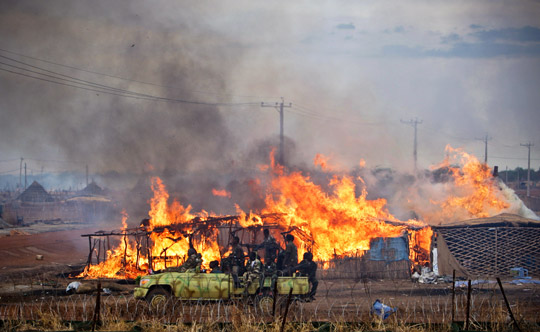June 08, 2011

As the eve of South Sudan’s independence rapidly approaches, incidents of new violence have occurred along the north/south border and new information about violence in South Sudan has emerged.
On June 6, fighting between the Sudanese Armed Forces (SAF) and Sudanese Peoples Liberation Army (SPLA) broke out in Kordofan state, around the capital Kadugli. While the details as yet remain unclear, initial reports indicate violence began on Sunday, June 5 at several locations, although the reports dispute how it began. Casualty estimates are difficult, given the on-going fighting, but UN officials on the ground have confirmed at least 6 are dead. The fighting escalated on June 6, when SAF moved into the town center. A report leaked to the New York Times indicated that the Sudanese government planned to move its forces to the 1956 north/south border and disarm any units associated with the SPLA. The areas impacted most by such moves would be the two northern states that border the south, Kordofan and Southern Blue Nile. Both states include populations who had previously fought with the SPLA during the war. While a northern wing of the SPLM has announced its intention to remain as an opposition political party in the north, the southern leadership has denied they retain any formal military presence in Kordofan and Southern Blue Nile.
As previously noted, the Sudanese Armed Forces moved into the disputed area of Abyei on May 21. Updated information indicates that 100 people were killed and 100,000 are displaced as a result of the SAF’s actions. The military offensive was accompanied by the destruction of homes and widespread looting. A confidential United Nations report leaked to the Associated Press, dated May 29, 2011, warned that the SAF’s invasion of Abyei has the potential to lead to “ethnic cleansing” if the thousands of displaced residents are not permitted to return. The Sudanese government announced on June 6, 2011, that it will work to create conditions for the thousands of internally displaced persons (IDPs) to return to their homes in Abyei, but it neglected to outline a firm strategy to actualize this plan. This announcement came the same day that Sudan rejected the UN Security Council’s calls for military withdrawal from the Abyei region.
In southern Sudan reports have emerged of an indiscriminate attack by SPLA forces against Nuer civilians on April 23 in Kaldak, a remote town in Jonglei state. According to civilians in the area, SPLA forces turned on civilians following a battle with a militia loyal to Maj. Gen. Gabriel Tanginye. The death toll may be as high as 254. Villagers also reported extensive looting following the fighting. An attempt by the UN to verify the reports was obstructed by the SPLA. Current estimates suggest more than 1,500 people have died due to recent violence across southern Sudan.
Violence in the South, combined with quickly deteriorating humanitarian access, creates immense difficulties for aid workers to reach the most vulnerable populations. The SPLA further compounds the fragile situation: aid workers in the region have reported that the SPLA is stealing humanitarian vehicles and supplies or restricting access to remote areas for their own enrichment.
